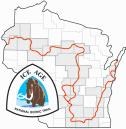IATCC - Stone Elephant
Please note that this is an EarthCache and as such logging this cache requires special tasks be performed. Those tasks are detailed below. For this EarthCache you will need a camera and a tape measure (or a good eye for length).
As this feature is located in the Kettle Moraine Oak Opening State Natural Area, please stay on trail at all times and take care not to disrupt the environment.
Trail expectations:
This portion of the Ice Age trail is rather steep and rugged with lots of protruding rocks. Please be sure you are prepared; bring water and other standard hiking supplies such as a first aid kit and bug spray. You should expect to walk about 3.6 miles round trip. For your efforts along the way you will be rewarded with views from one of the highest features in the county. The elephant you are seeking is on a short spur off of the IAT.
The Stone Elephant is located about a mile north of Bald Bluff. There is an interpretive sign on the Ice Age Trail which makes note of and directs you to this feature. Early settlers named the rock "Stone Elephant" due to it's color size and shape. This has been a popular destination for some time with early travelers visiting via horse drawn surreys.
Stone Elephant is an "erratic." An erratic is a piece of rock that differs from the size and type of rock native to the area in which it rests. Erratics often travel hundreds of miles and can range in size from pebbles to large boulders. Early scientists believed these rocks were washed here in great floods. Today most scientists believe that erratics were transported to this area on great sheets of ice. When these sheets melted roughly 10,000 years ago the erratics were deposited where we find them today. One theory as to how these rocks got onto ice sheets was that they were deposited there during landslides or rock-falls as the glaciers scoured the Earth.
You and the elephant are standing deep in the Kettle Moraine. The Kettle Moraine is a large moraine (a mass of earth and rock debris carried by an advancing glacier and left at its front and side edges as it retreats) which stretches from Walworth County in the south to Kewaunee County in the north. The moraine was created when the Green Bay Lobe of the glacier, on the west, collided with the Lake Michigan Lobe of the glacier, on the east, depositing sediment. Kames (a ridge of sand and gravel left by a melting glacier), kettles (a steep-sided basin, in a glacial drift deposit, caused by the melting of an ice mass left behind as a glacier retreats) and erratics are commonly found here.
* To claim this EarthCache as a find: *
1. Take and upload (optional) with your "found it" log a photo at the informational sign which directs you to the erratic; include your team and GPS (or your GPS alone).
2. Stone on average weighs about 2.7 times as much as water.
Water weighs 62.428 pounds per cubic foot so stone on average weighs 168 Lbs per cubic foot.
For simplicity sake, let's assume this rock is rectangular and wholly above ground.
E-Mail me: How many pounds does it weigh?
Length_____ X Width_____ X Height_____ X 168 =_____
*Note of comparison on weight:
A typical car weighs about 4,000 pounds
African elephants (males) weigh up to 15,000 Lbs
3. E-Mail me: Explain one possible way in which the erratic came to rest where it is today.
|
 IATCC is the cache designation to highlight a series of EarthCaches along the Ice Age National Scenic Trail grouped into a special category called "ColdCache." IATCC is the cache designation to highlight a series of EarthCaches along the Ice Age National Scenic Trail grouped into a special category called "ColdCache."
The Ice Age Trail is one of eleven (11) National Scenic Trails designated by the National Park Service. This unique trail is entirely within the state of Wisconsin and follows along the terminal moraine of the most recent glacier.
This project is supported by the Ice Age Trail Alliance. The goal is to bring more visitors to the trail and promote public awareness, appreciation, and understanding of Wisconsin’s glacial landscape.
More information on the Ice Age Trail Atlas, the ColdCache Project and Awards Program is available at: http://www.iceagetrail.org/hiking-awards-and-programs.
|
The Geocache Notification Form has been submitted to Paul Sandgren of the Wisconsin DNR. Geocaches placed on Wisconsin Department of Natural Resource managed lands require permission by means of a notification form. Please print out a paper copy of the notification form, fill in all required information, then submit it to the land manager. The DNR Notification form and land manager information can be obtained at: http://www.wi-geocaching.com/modules.php?name=Wiki&pagename=Hiding%20A%20Cache
;
References:
http://en.wikipedia.org/wiki/Glacial_erratic
http://en.wikipedia.org/wiki/Kettle_Moraine
;
Congratulations to grcarlson for the FTF on September 18, 2009.